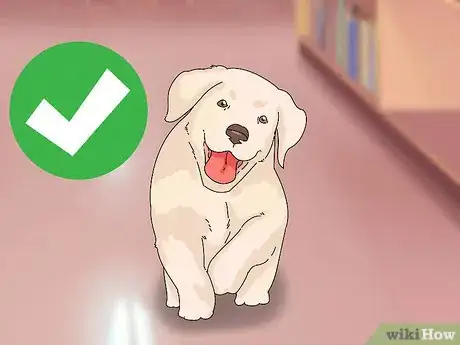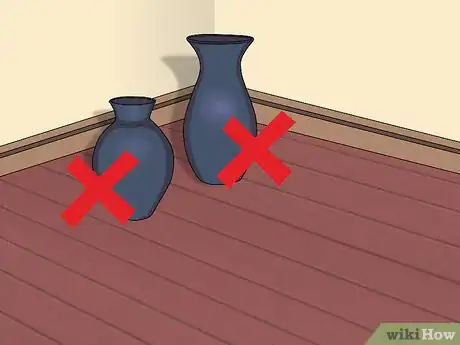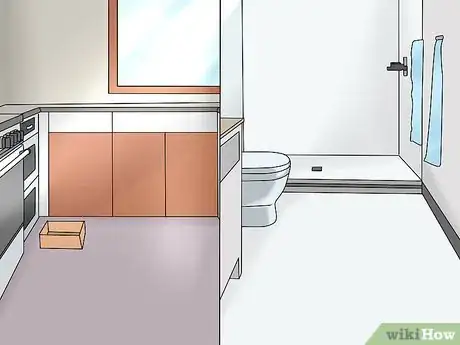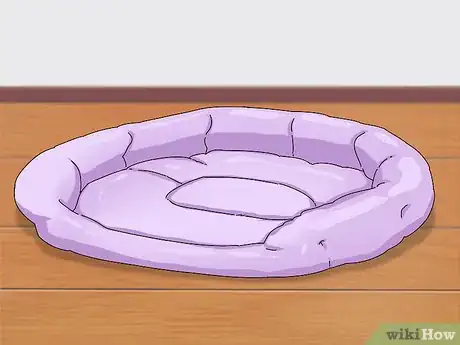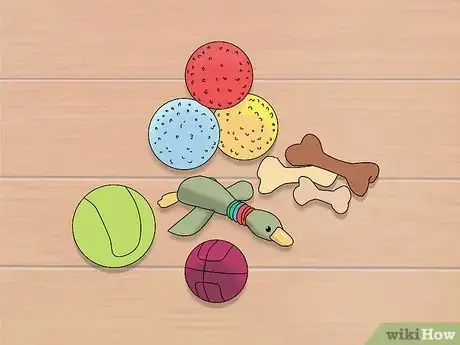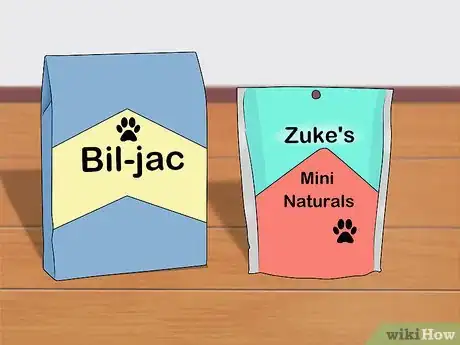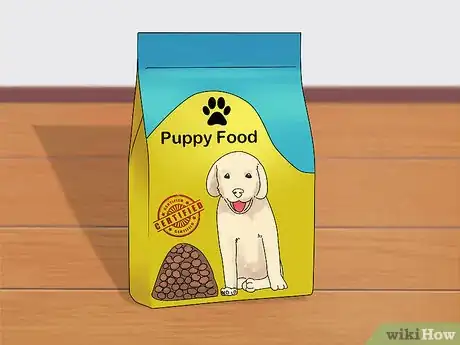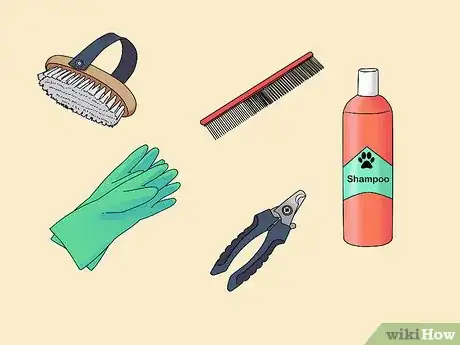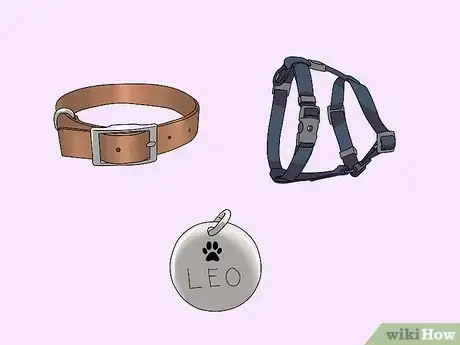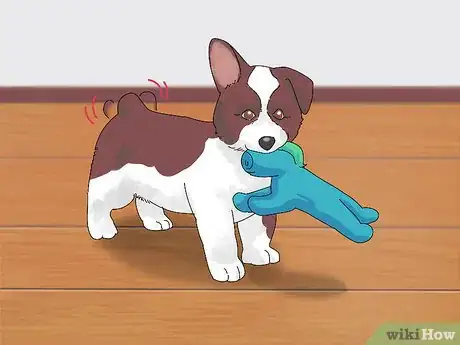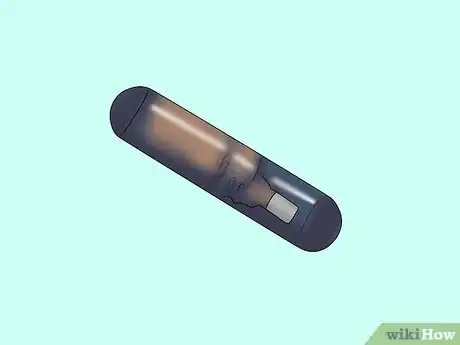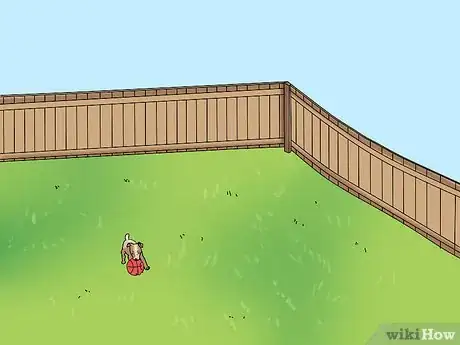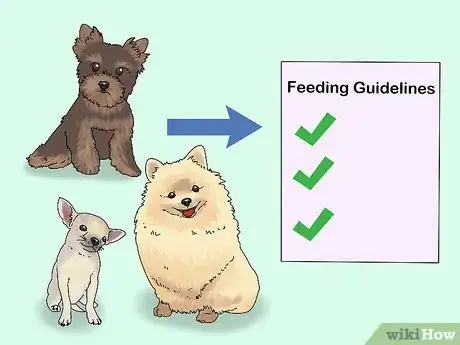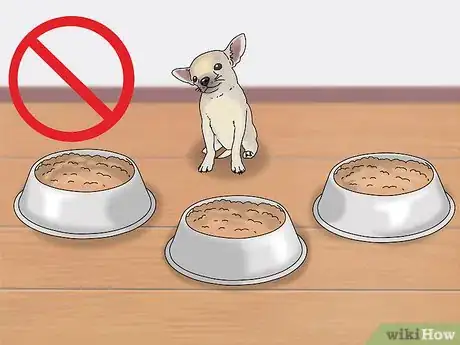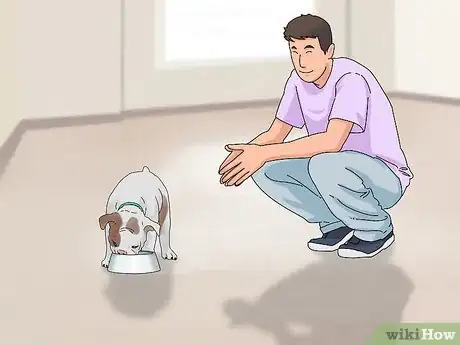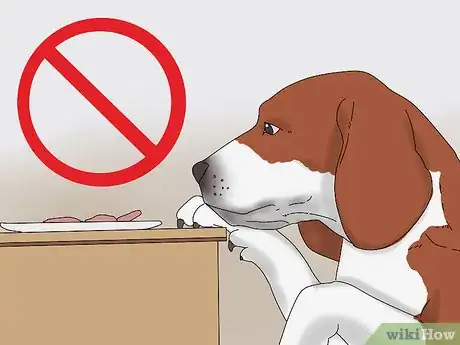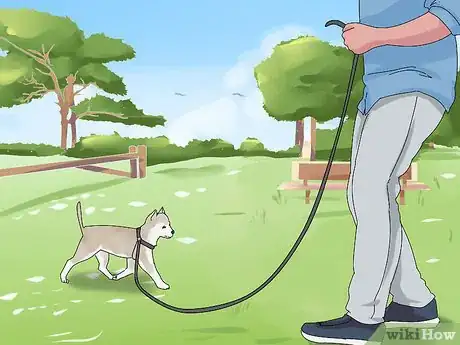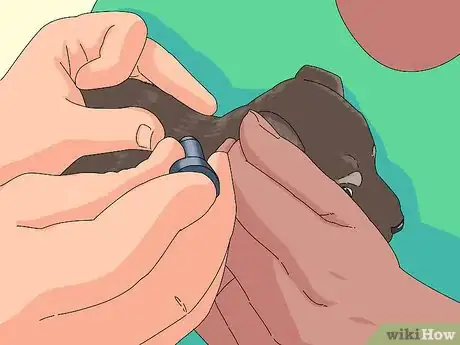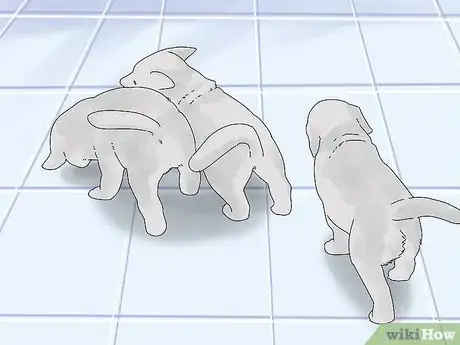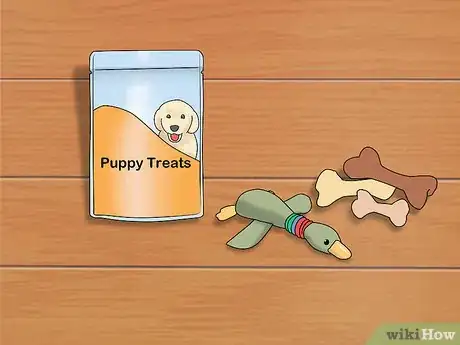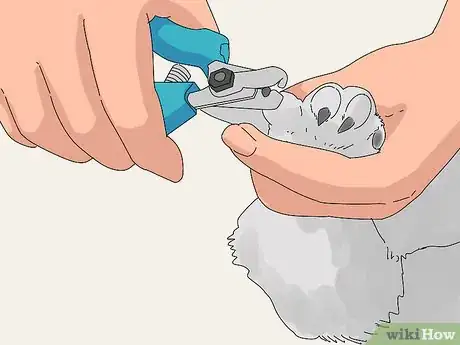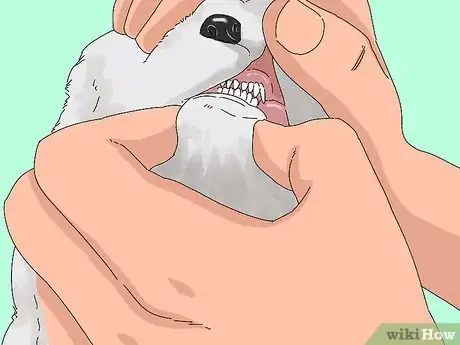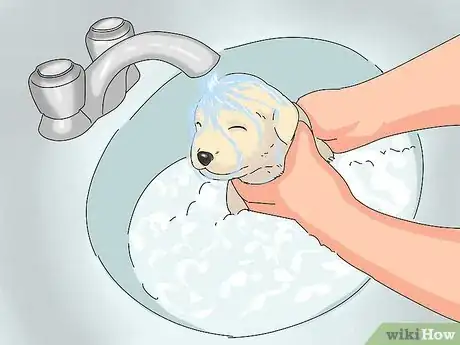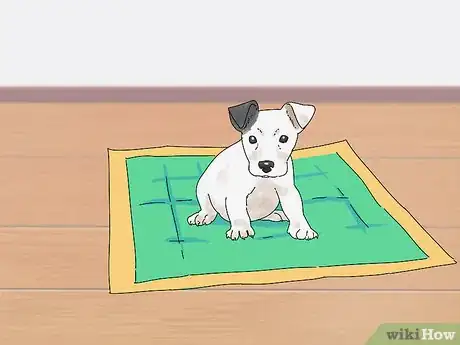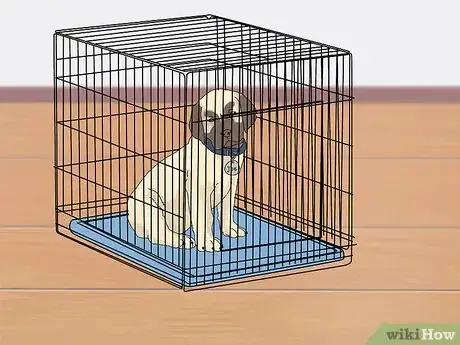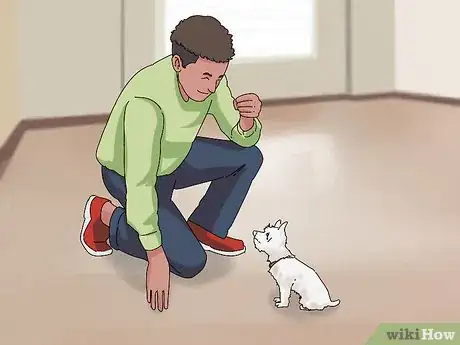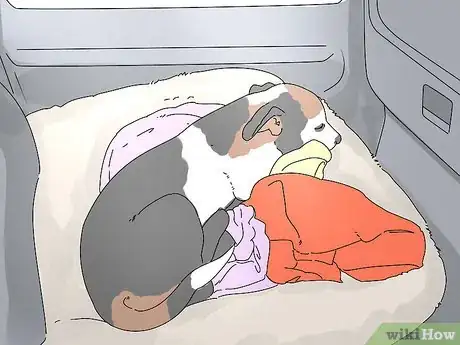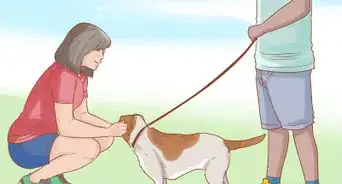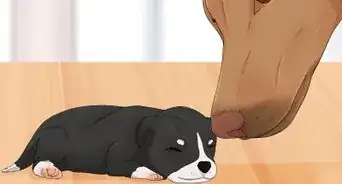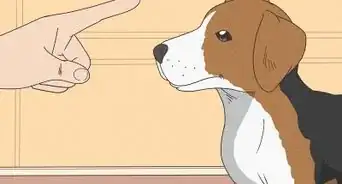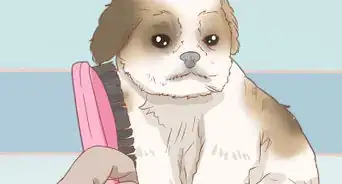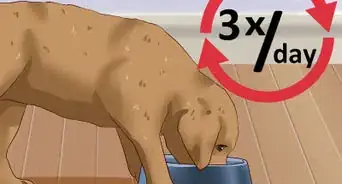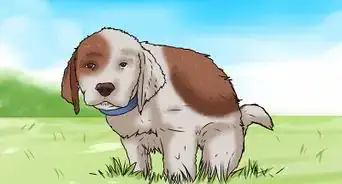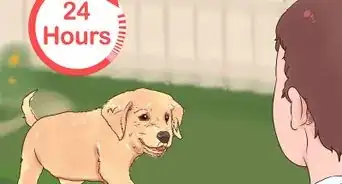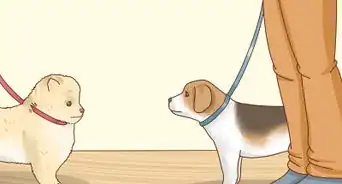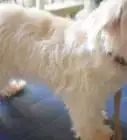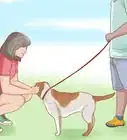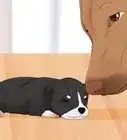This article was co-authored by Brian Bourquin, DVM. Brian Bourquin, better known as “Dr. B” to his clients, is a Veterinarian and the Owner of Boston Veterinary Clinic, a pet health care and veterinary clinic with three locations, South End/Bay Village, the Seaport, and Brookline, Massachusetts. Boston Veterinary Clinic specializes in primary veterinary care, including wellness and preventative care, sick and emergency care, soft-tissue surgery, dentistry. The clinic also provides specialty services in behavior, nutrition, and alternative pain management therapies using acupuncture, and therapeutic laser treatments. Boston Veterinary Clinic is an AAHA (American Animal Hospital Association) accredited hospital and Boston’s first Fear Free Certified Clinic. Brian has over 19 years of veterinary experience and earned his Doctor of Veterinary Medicine from Cornell University.
There are 9 references cited in this article, which can be found at the bottom of the page.
wikiHow marks an article as reader-approved once it receives enough positive feedback. This article received 15 testimonials and 94% of readers who voted found it helpful, earning it our reader-approved status.
This article has been viewed 996,701 times.
A puppy is a fun, exciting, and adorable addition to your family. Puppies are also a lot of work, but if you remain committed and stick with it, you will be rewarded with a loyal, happy, and loving companion. Your new puppy should be at least eight weeks old. Pups are usually weaned at eight weeks, and it's unhealthy to remove them from their mothers before then. If your puppies are younger than this, check out How to Care for Newborn Puppies.
Steps
Bringing the Puppy Home
-
1Make sure that the puppy you are getting is right for you. Does its coat suit your climate? Is it small enough to live in your apartment or house? Does its energy level suit the amount of exercise you can provide? Careful consideration of these questions will ensure your puppy's well-being and will also impact the happiness of your household.
-
2Puppy-proof your house. Puppies love to explore with their mouths. To keep your puppy and house safe, you'll need to take a few precautions.
- Remove breakable items from the area where you plan to keep your puppy.
- Keep all electrical cords raised or covered, and close all low windows.
- Lock away toxic cleaning supplies/chemicals.
- Get a trash can that is too tall for him to get into and too heavy to knock over, or store the trash can in a cabinet.
- Consider getting a folding gate or exercise pen to keep him confined to a certain room or area.
Advertisement -
3Provide space for the puppy.[1] The kitchen or bathroom is an ideal place for his bed during the day because those rooms are usually warm and have washable floors. At night, keep your puppy in his crate in your bedroom. This will allow you to hear him during the night, so you will know if he needs to go outside to relieve himself.
-
4Buy two metal (stainless steel) bowls — one for food and one for water. These are better than glass because they do not chip and stay cleaner. If you have other pets, be sure to give each pet their own food and water bowls to avoid conflict. At feeding time, you will separate them to prevent fighting over food and to ensure each pet gets the nutrition they need.
-
5Provide a puppy bed. You might consider a crate with a crate pillow, a snuggle nest, or a wicker basket with a lot of towels. Whichever option you choose, make sure it is always soft, clean, comfy, and dry. Have a blanket on hand in case of cool weather. To avoid conflict, each pet should have their own bed.
-
6Shower him with toys. Your puppy will be a ball of boundless energy, so make sure you get plenty of toys, including both chew toys and soft toys. The toys should be sturdy enough to prevent choking hazards. Don't give rawhide to puppies as a toy; use it only as a treat and watch him as he chews.
-
7Choose the right puppy treats. Training treats should be healthy, small, and easily chewed or swallowed.[2] Their purpose is to communicate quickly that the puppy did something you liked, but you don't want to wait around for them to finish eating when you want to continue the training.
- Consider “Bil-Jac” or “Zuke’s Mini Natural” treats.
- Look for treats about the size of a pencil eraser head. If your treats are larger, break them up into smaller pieces.
- Make sure you get a variety: crunchy and soft. The soft will be good for training, and the crunchy will help clean teeth.
-
8Get him quality puppy food. Kibble, canned food, home cooked food, and a raw diet are all options for a puppy, but discuss each with your veterinarian. When you first get your puppy, ask the breeder, rescue group, or shelter what food your puppy was eating with them. You can continue that diet when they first come to their new home. If you want to make a change, do so after a few weeks, and transition to the new food gradually, over a week or so. Changing foods abruptly can cause vomiting or diarrhea.
- Buy a puppy food with no dyes, artificial flavors, or preservatives, as many dogs are allergic to these additives.
- A raw or home-cooked meal is a serious commitment, as you will need to take extra steps to prepare the food and ensure your puppy's nutritional needs are met. Discuss these options with the veterinarian first.
-
9Buy the basic grooming tools. At the very least, every dog owner needs a bristle brush, comb, rubber gloves, nail clippers, dog shampoo, dog conditioner, dog toothpaste, dog toothbrush, and towels. Grooming isn't just about keeping your dog pretty. These tools will keep him healthy and happy, too.
-
10Provide a nylon harness, flat collar (webbed nylon or leather), and metal tag. Poorly sized collars can hurt puppies' necks and injure their throats. Remember when sizing the harness or collar that your puppy will grow.
-
11Get the puppy comfortable in your home. Your puppy might be frightened when introduced to his new home for the first time. Give him extra love and attention those first few days. While wearing a light leash, let your puppy investigate different parts of the house and yard while you follow him around. You don’t have to show him everything on the first day, but the common areas are a good start.
- Do not let your puppy roam free because accidents will happen.
- Have your puppy sleep in your room in his crate at night so he doesn't feel isolated or alone.
-
12Pet him often. It's important to stroke your pet's body, legs, and head often throughout the day. This will not only make him feel loved, but also allow you to create a strong bond with your puppy.[3] It will also get him used to being touched and handled.
- Pet your puppy and stroke down his legs, touch his paws, and his belly so he will be comfortable with this contact in the future when you need to have him groomed or clip his nails.
-
13Handle your puppy with care. Puppies, like human babies, are fragile. Gently scoop your puppy into your arms if you need to pick him up. Keep one hand on his chest at all times and support his bottom with your other hand.
-
14Protect your puppy. Puppies are naturally curious, and even with the most attentive care they sometimes escape the yard and get lost. Make sure your puppy wears a comfortable adjustable collar with a tag that lists your contact information. The tag should include your puppy's name, along with your address and phone number.
- Many jurisdictions require you to get a dog license. It's a good idea to get your puppy licensed even if it's not required.
- Your puppy will need to have its rabies vaccination to receive his dog license.
-
15Have a microchip implanted. The microchip is tiny — about the size of a grain of rice — and is placed under the skin, behind the neck and above the shoulders. You will register the microchip with your contact information when the vet implants it in your puppy. If he ever gets lost, a vet or shelter will be able to scan the chip and call you to reunite you with your pet.
- Even if your puppy has a collar and tag, experts recommend that all pets have microchips that can't be removed.
-
16Provide a safe area for him to play. A securely fenced yard is ideal. Experiment a little to find out which toys he likes best. Indoors, use an exercise pen to confine your dog in his own “playpen” or play area until he is house trained.[4]
Feeding Your Puppy
-
1Choose the right dog food. While it's tempting to go for the cheap stuff, this is not the best choice for your dog. Look for foods that incorporate high-quality proteins from fish, chicken, lamb, beef, and/or eggs. Talk to your veterinarian about diet choices. If you plan to change his food, do so gradually to reduce the chance of an upset stomach.
-
2Feed your puppy properly. Give him small amounts of food formulated for puppies several times a day.[5] The amount of food for each meal depends on the breed and size; look up the recommended amounts for your breed. Feed your puppy only the smallest amount recommended for his breed, age, and size. Increase the amount if the puppy seems too thin, or as directed by your veterinarian. The number of daily feedings depends on the puppy's age:
- six – 12 weeks: three to four times daily
- 12 – 20 weeks: three times daily
- 20+ weeks: two times daily
-
3Follow the special feeding guidelines for small or toy breed dogs. Very small breeds (Yorkshire Terriers, Pomeranians, Chihuahuas, etc.) may be prone to low blood sugar. These puppies often need access to food all day long (or every two to three hours) until about 6 months of age. This prevents their blood sugar from dipping too low, which can lead to weakness, confusion, and even seizures.
-
4Avoid buffet-style feeding. Meal feeding will help with housebreaking and prevent your dog from gorging on food. Furthermore, your puppy will bond with you by associating good things like food with the humans in the household. The puppy should have a limited time, probably 20 minutes, to finish its food.[6]
-
5Watch your puppy eat. Watching your puppy eat is a good way to gauge his health. If he seems uninterested in his food all of a sudden, take note of it. The behavior may be due to a simple food preference issue, but it could also be a medical concern.
- It's your job to notice any change in his behavior. Follow through with a call to your veterinarian, and take the proper steps to uncover the cause of the change.
-
6Do not feed your dog table scraps. It may be tempting, but remember that human food can make your dog unhealthily obese. Alongside the serious health risk, feeding your dogs table scraps can train them to beg — one of the hardest habits to break.
- To ensure good health, feed your dog food specifically designed for him.
- Ignore him completely while you're eating at the table.
- Check with your veterinarian about “people” foods that are safe for dogs. These might include roasted chicken breast or fresh green beans.
- Foods high in fats can cause problems like pancreatitis in dogs.
-
7Protect your dog from toxic foods. Your puppy’s body is very different from yours. Some of the foods you are able to digest are dangerously toxic to him. If your puppy eats something toxic, call the Animal Poison Control Center immediately (888-426-4435 in the US) and your veterinarian. A partial list of foods of such foods includes:
- Raisins
- Grapes
- Xylitol (a sweetener)
- Tea
- Alcohol
- Garlic
- Onions
- Avocados
- Salt
- Chocolate
-
8Provide adequate fresh water. Unlike food, you should leave a full bowl of fresh water out for your pets at all times. Be aware that your puppy will have to urinate shortly after drinking a large amount of water. Take him to your fenced backyard on a leash so he doesn't have accidents in your house.
Keeping Your Dog Healthy
-
1Keep your puppy's environment safe. An unsafe or dirty environment can be harmful to his overall well-being and can cost you a lot of money in veterinary bills.
- Wash dirty bedding right away. House-train your puppy, and replace bedding ASAP if you find urine or feces.
- Get rid of harmful plants. There are many common plants that are toxic to puppies who like to chew. Keep lily of the valley, oleander, azalea, yew, foxglove, rhododendron, rhubarb, and shamrock far away from your puppy. Refer to this list from the ASPCA to learn more about which plants are safe for your home when you have pets: https://www.aspca.org/pet-care/animal-poison-control/toxic-and-non-toxic-plants
-
2Make sure he gets plenty of exercises. Different breeds need varying amounts of exercise. (This is a factor you should consider when choosing a puppy). Take your puppy into the yard or garden on a leash after meals to explore and get a little exercise. Begin taking him on short walks outside the yard when your veterinarian says it is safe. It is normal for puppies to have short bursts of energy followed by long naps.
- While your puppy's body is still developing, avoid rough play and strenuous exercise. Save long (over one mile) runs until he's at least 9 months old.
- Give your puppy about an hour of walk-time a day, broken into two to four walks. Allow him to interact with other (friendly) dogs he meets. (Do this only once your puppy has finished his vaccination series).
-
3Choose a veterinarian if you don’t already have one.[7] Ask your friends for veterinarian recommendations. Once you have a few options, visit each clinic to see which one you like best. Choose a clinic that is friendly, well managed, and smells clean. Ask questions to the vet and the staff—they should always answer to the best of their ability. Be sure you feel comfortable with whichever vet you choose.
-
4Vaccinate your puppy. When he's six to nine weeks old, take him to the vet to begin his vaccination series. Talk to the vet about distemper, parainfluenza, canine hepatitis, and parvovirus. They may have suggestions for other important vaccines as well, depending on the risks of your particular dog and your specific area.
- Make sure to talk about deworming medication during your first vet visit. The veterinarian may recommend deworming for routine parasites like roundworms right away. Or, he or she may want to get a stool sample for fecal analysis to verify parasites before prescribing medication.
- Deworming is a good idea not only for your puppy's health but also for your own. Many of the parasites that infect your puppy can be passed to humans and cause health problems in your family.
- After your first visit, return to the vet for a rabies vaccination when your puppy is 12 to 16 weeks old. Ask your veterinarian about the recommended (and legally required) rabies vaccination protocol for your area.
-
5Socialize your puppy. The prime socialization period for puppies is from seven to 16 weeks of age. You should strongly consider puppy preschool to acclimate him to other dogs before that period runs out.[8] Puppy preschools provide safe, supervised play for puppies still finishing their vaccination series. Most puppies have completed their distemper/parvo series of vaccines by the age of 16 weeks.
-
6Get your puppy spayed or neutered.[9] Talk to your veterinarian about their recommendations for the timing of the surgery. Vets usually recommend waiting until after the vaccines, but there may be other considerations.
- For instance, spay procedures are more complex and expensive for larger breeds. The vet may recommend spaying before she reaches 50 or 60 pounds if your dog is particularly large.
- Spay female dogs before their first heat cycle. This reduces the risk of pyometra, ovarian cancer, and mammary tumors.[10]
-
7Make vet trips fun. Bring treats and toys to vet appointments to teach your puppy to enjoy (or at least tolerate) the experience. Before his first checkup, introduce your puppy to having his feet, tail, and face touched. That way, it won't be so strange for him when the vet inspects him.
-
8Watch for health problems. Keep an eye on your puppy to catch any problems early. The eyes should be bright, and the eyes and nostrils should be free of discharge. The puppy's coat should be clean and shiny; watch out formatting or thinning. Check your pup for bumps, inflammation, or rashes on the skin, as well as signs of diarrhea around the tail.
Grooming Your Puppy
-
1Brush your puppy daily. Brushing keeps your pet clean and healthy and allows you to check his skin and fur for problems. Brush type and other washing and grooming requirements vary by breed. Check with your veterinarian, groomer or breeder for more information.
- Brush all over the puppy, including his belly and hind legs.
- Start when your puppy is young so that he isn't afraid of the brush.
- Start in short lessons, using treats and toys. Brush him for only a few minutes at a time at first to avoid overwhelming him.
- Do not brush the face and legs with instruments that may cause pain.
-
2Trim your puppy's nails. Ask your veterinarian or groomer to show you the proper nail-cutting technique. Improper technique can hurt your puppy if you cut into the quick of his nail. This is especially important if your puppy has black nails that make it hard to spot the quick.
- Nails that are too long can cause strain to your dog's wrists, as well as damage floors, furniture, and possibly people.
- Plan to trim your puppy's nails every two to four weeks unless directed otherwise by your vet.
- Use treats and praise, and start with only trimming a few at a time to avoid overwhelming him.
-
3Keep your puppy's teeth and gums healthy. Chew toys help a puppy keep his teeth healthy. Toothbrushes and toothpaste made specifically for dogs are also helpful in keeping your pup's teeth clean and healthy. Acclimate your puppy to having his teeth brushed slowly so that it is a positive experience for him.[11] Don’t forget to shower him with treats and praise!
-
4Only bathe your puppy when he needs it. Washing more than necessary can dry out your dog's skin and strip important oils from his coat. Gradually introduce your puppy to water and the process of getting bathed. Give him treats and praise, as always.
Training Your Puppy
-
1Housebreak your dog. Start this process the first day you bring your puppy home. The longer you wait, the more mess you'll have to deal with, and the harder it will be to train your dog. Consider using training pads for the first few days. While these should not replace taking him outside, they're useful as an intermediate stage. Consider them especially if you don't have a backyard.
- Remember that a puppy has a tiny bladder and may need to go outside as frequently as every 30 minutes.
- Confine the puppy with the newspapers or training pads in the exercise pen when unsupervised.
- Don't let him wander the house. If you are not playing with him, place him in his crate or exercise pen, or tether him to your belt or sitting area.
- Pay attention to cues that he needs to eliminate and take him outside immediately. Take him to the same spot each time.
- Praise (and treat) him immediately for using the outdoors!
-
2Consider crate training your dog.[12] Crate training is helpful for many reasons. It curbs destructive behavior, allowing you to sleep and leave your dog alone without worrying. It is also an effective method of potty training (when used correctly).
-
3Teach your dog basic commands. A well-mannered dog is a joy to have in the family. Start out on the right paw by teaching good habits early, and you and your pet will have a better relationship. It's harder to break bad habits than to create good ones in the first place.
- Teach your dog to come.
- Teach your dog to sit.
- Teach your dog to lie down.
-
4Get your dog used to car rides. Take your puppy on regular car rides to get him used to traveling with you. Otherwise, the car ride can cause anxiety. If your puppy gets carsick, talk to your veterinarian about medication to manage nausea. This will make the ride more pleasant for both of you.
- Make sure your dog is secured in the car. Consider a dog car seat, safety harness, barrier, or crate to avoid accidents and keep your dog safe.[13]
- Remember to never leave your dog in the car on cold or warm days. The temperature inside a car can rise rapidly on warm or hot days, endangering your dog's life. On an 85°F (29.4°C) day, the temperature inside a car can rise to 102°F (39°C) within 10 minutes, even with the windows cracked. If it is too cold outside, dogs can freeze when left in the car.
-
5Enroll in an obedience class for puppies. This will help you better train your dog, of course. But it will also socialize him, helping him learn how to act around unfamiliar dogs and people.
Expert Q&A
Did you know you can get expert answers for this article?
Unlock expert answers by supporting wikiHow
-
QuestionAt what point should I transition my puppy to solid food?
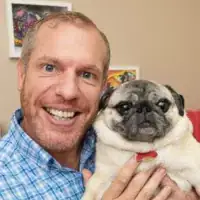 Brian Bourquin, DVMBrian Bourquin, better known as “Dr. B” to his clients, is a Veterinarian and the Owner of Boston Veterinary Clinic, a pet health care and veterinary clinic with three locations, South End/Bay Village, the Seaport, and Brookline, Massachusetts. Boston Veterinary Clinic specializes in primary veterinary care, including wellness and preventative care, sick and emergency care, soft-tissue surgery, dentistry. The clinic also provides specialty services in behavior, nutrition, and alternative pain management therapies using acupuncture, and therapeutic laser treatments. Boston Veterinary Clinic is an AAHA (American Animal Hospital Association) accredited hospital and Boston’s first Fear Free Certified Clinic. Brian has over 19 years of veterinary experience and earned his Doctor of Veterinary Medicine from Cornell University.
Brian Bourquin, DVMBrian Bourquin, better known as “Dr. B” to his clients, is a Veterinarian and the Owner of Boston Veterinary Clinic, a pet health care and veterinary clinic with three locations, South End/Bay Village, the Seaport, and Brookline, Massachusetts. Boston Veterinary Clinic specializes in primary veterinary care, including wellness and preventative care, sick and emergency care, soft-tissue surgery, dentistry. The clinic also provides specialty services in behavior, nutrition, and alternative pain management therapies using acupuncture, and therapeutic laser treatments. Boston Veterinary Clinic is an AAHA (American Animal Hospital Association) accredited hospital and Boston’s first Fear Free Certified Clinic. Brian has over 19 years of veterinary experience and earned his Doctor of Veterinary Medicine from Cornell University.
Veterinarian It's really only during the transition from weaning that you might soften the food, as puppies don't have the teeth development they need yet. By the time they are eight weeks old, most dogs have proper teeth for puppy food, which is going to be smaller in size and easier to chew. As they get older, know that variety is a good idea when feeding your dog.You want to be giving them canned food and dry food so they can experience both and get used to it.
It's really only during the transition from weaning that you might soften the food, as puppies don't have the teeth development they need yet. By the time they are eight weeks old, most dogs have proper teeth for puppy food, which is going to be smaller in size and easier to chew. As they get older, know that variety is a good idea when feeding your dog.You want to be giving them canned food and dry food so they can experience both and get used to it. -
QuestionHow can I care for my dog after they have been spayed or neutered?
 Brian Bourquin, DVMBrian Bourquin, better known as “Dr. B” to his clients, is a Veterinarian and the Owner of Boston Veterinary Clinic, a pet health care and veterinary clinic with three locations, South End/Bay Village, the Seaport, and Brookline, Massachusetts. Boston Veterinary Clinic specializes in primary veterinary care, including wellness and preventative care, sick and emergency care, soft-tissue surgery, dentistry. The clinic also provides specialty services in behavior, nutrition, and alternative pain management therapies using acupuncture, and therapeutic laser treatments. Boston Veterinary Clinic is an AAHA (American Animal Hospital Association) accredited hospital and Boston’s first Fear Free Certified Clinic. Brian has over 19 years of veterinary experience and earned his Doctor of Veterinary Medicine from Cornell University.
Brian Bourquin, DVMBrian Bourquin, better known as “Dr. B” to his clients, is a Veterinarian and the Owner of Boston Veterinary Clinic, a pet health care and veterinary clinic with three locations, South End/Bay Village, the Seaport, and Brookline, Massachusetts. Boston Veterinary Clinic specializes in primary veterinary care, including wellness and preventative care, sick and emergency care, soft-tissue surgery, dentistry. The clinic also provides specialty services in behavior, nutrition, and alternative pain management therapies using acupuncture, and therapeutic laser treatments. Boston Veterinary Clinic is an AAHA (American Animal Hospital Association) accredited hospital and Boston’s first Fear Free Certified Clinic. Brian has over 19 years of veterinary experience and earned his Doctor of Veterinary Medicine from Cornell University.
Veterinarian The recommendation still is being neutered at six months for the average dog, especially in an urban environment. The aftercare for a sterile procedure really depends most on keeping them quiet during the initial recovery period. While they are healing, you don't want your dog jumping around or running off leash playing. It's also important they wear a collar or no-lick shirt to keep from licking.
The recommendation still is being neutered at six months for the average dog, especially in an urban environment. The aftercare for a sterile procedure really depends most on keeping them quiet during the initial recovery period. While they are healing, you don't want your dog jumping around or running off leash playing. It's also important they wear a collar or no-lick shirt to keep from licking. -
QuestionHow many times a day should you feed a puppy?
 Brian Bourquin, DVMBrian Bourquin, better known as “Dr. B” to his clients, is a Veterinarian and the Owner of Boston Veterinary Clinic, a pet health care and veterinary clinic with three locations, South End/Bay Village, the Seaport, and Brookline, Massachusetts. Boston Veterinary Clinic specializes in primary veterinary care, including wellness and preventative care, sick and emergency care, soft-tissue surgery, dentistry. The clinic also provides specialty services in behavior, nutrition, and alternative pain management therapies using acupuncture, and therapeutic laser treatments. Boston Veterinary Clinic is an AAHA (American Animal Hospital Association) accredited hospital and Boston’s first Fear Free Certified Clinic. Brian has over 19 years of veterinary experience and earned his Doctor of Veterinary Medicine from Cornell University.
Brian Bourquin, DVMBrian Bourquin, better known as “Dr. B” to his clients, is a Veterinarian and the Owner of Boston Veterinary Clinic, a pet health care and veterinary clinic with three locations, South End/Bay Village, the Seaport, and Brookline, Massachusetts. Boston Veterinary Clinic specializes in primary veterinary care, including wellness and preventative care, sick and emergency care, soft-tissue surgery, dentistry. The clinic also provides specialty services in behavior, nutrition, and alternative pain management therapies using acupuncture, and therapeutic laser treatments. Boston Veterinary Clinic is an AAHA (American Animal Hospital Association) accredited hospital and Boston’s first Fear Free Certified Clinic. Brian has over 19 years of veterinary experience and earned his Doctor of Veterinary Medicine from Cornell University.
Veterinarian
Warnings
- Do not leave anything lying around that your puppy could choke on.⧼thumbs_response⧽
- This page is only for puppies eight weeks old and older. You should not buy or adopt a puppy younger than eight weeks old because they are too young to go to a new home. In some states, that is the law.⧼thumbs_response⧽
- Don't expose him to unfamiliar dogs without all their vaccines finished. You should socialize your puppy early with friendly, vaccinated dogs on the uncontaminated property.⧼thumbs_response⧽
References
- ↑ Brian Bourquin, DVM. Veterinarian. Expert Interview. 20 December 2019.
- ↑ Brian Bourquin, DVM. Veterinarian. Expert Interview. 20 December 2019.
- ↑ http://www.newscientist.com/article/dn16412-pet-dogs-rival-humans-for-emotional-satisfaction.html
- ↑ http://www.midwestpetproducts.com/midwestexercisepens
- ↑ Brian Bourquin, DVM. Veterinarian. Expert Interview. 20 December 2019.
- ↑ http://pets.webmd.com/dogs/ss/slideshow-taking-care-of-puppy
- ↑ http://www.aspca.org/pet-care/dog-care/find-right-vet
- ↑ http://www.dog-obedience-training-review.com/puppy-socialization.html
- ↑ Brian Bourquin, DVM. Veterinarian. Expert Interview. 20 December 2019.
- ↑ http://www.aspca.org/pet-care/top-10-reasons-spay-or-neuter-your-pet
- ↑ http://www.aspca.org/pet-care/dog-care/ten-steps-your-dogs-dental-health
- ↑ Brian Bourquin, DVM. Veterinarian. Expert Interview. 20 December 2019.
- ↑ http://dogtime.com/reference/dog-travel/66-driving-with-dog
About This Article
To take care of puppies, puppy-proof your space by removing breakable items, raising or covering electrical cords, and locking up toxic cleaning supplies. Set out a stainless steel bowl for food and another one for water, and be sure to provide quality puppy food, fresh water, and healthy treats. Interact with your pup frequently to establish a bond and help it acclimate to its new home. Don't forget to take your puppy to a vet for vaccinations and a microchip implant! For tips on grooming and training your puppy, read on!
